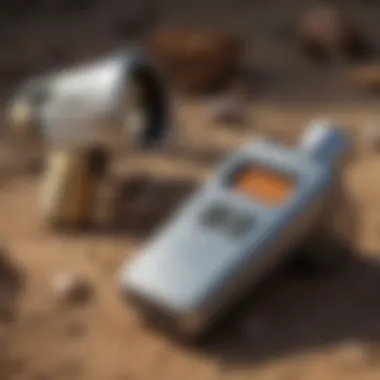Unlocking the Secrets: How to Identify Precious Metals in Electronics


Rock and Fossil Identification
When it comes to identifying precious metals in electronics, it's essential to understand the different types of metals commonly used. These metals can range from gold and silver to platinum and palladium. Each metal has distinctive characteristics such as color, density, and conductivity, which are key indicators when trying to distinguish one from another. Tools like magnifying glasses, acid testing kits, and electronic testers can aid in this identification process.
Collecting Tips and Techniques
For enthusiasts looking to collect precious metals from electronics, it's crucial to follow best practices to ensure successful extraction. Locating prime collecting sites, such as old electronic devices or motherboards, can provide a steady supply of metals. Safety is paramount during the extraction process, as some electronic components may contain hazardous materials. Utilizing tools like gloves, masks, and protective eyewear is advised to prevent exposure to harmful substances.
Preservation and Display
Once precious metals have been collected, proper preservation is key to maintaining their value. Techniques like encapsulation, protective coatings, and storing in airtight containers can prevent corrosion and tarnishing. It's also important to consider creative display ideas to showcase the metals effectively. Whether framing them in displays or incorporating them into jewelry pieces, creativity plays a vital role in highlighting the beauty of these metals.
Geological Insights
Exploring the geological origins of precious metals can provide valuable insights into their significance. Understanding the geological formations and processes where these metals originate sheds light on their rarity and value. Delving into the historical context of these metals, including notable discoveries and mining practices, presents a holistic view of their importance in various industries. This geological perspective not only enriches one's knowledge but also deepens appreciation for the intrinsic value of these precious metals.
Introduction
In this detailed article, we delve into the intricate process of identifying precious metals present in electronic devices. The significance of this topic lies in the increasing interest among rock and fossil collectors towards valuing and understanding the materials they encounter. By mastering the art of recognizing precious metals, collectors can accurately assess the worth of their findings, gaining insights into the composition and potential value of electronic components.


Understanding the Importance of Identifying Precious Metals
Exploring the importance of identifying precious metals unveils a world of opportunities for collectors. By recognizing these metals, individuals can differentiate between common materials and rare finds. This skill empowers collectors to make informed decisions regarding the value and potential uses of the metals they unearth. Understanding the properties and significance of precious metals elevates a collector's expertise, enhancing their ability to curate meaningful and valuable collections.
Overview of Precious Metals Commonly Found in Electronics
Precious metals commonly encountered in electronic devices include gold, silver, copper, and platinum. These metals are prized for their conductivity, resistance to corrosion, and aesthetic appeal. Gold, with its lustrous appearance and malleability, often adorns electronic connectors and circuits. Silver, another highly conductive metal, is found in various components due to its affordable cost and excellent electrical properties. Copper, widely used for its superb conductivity, is a staple in electronic wiring. Platinum, though less common, is valued for its resistance to oxidation and durability in extreme conditions.
Benefits of Identifying Precious Metals in Electronics
The benefits of identifying precious metals in electronics are multifaceted. By distinguishing these metals, collectors can accurately gauge the value of electronic pieces, facilitating informed decision-making when acquiring or selling items. Knowledge of precious metals enhances a collector's expertise, enabling them to identify high-value components and compounds. Additionally, understanding these materials opens doors to potential collaborations with experts in the field and provides insights into the historical and technological significance of the metals used in electronic devices.
Tools and Equipment Needed
In the realm of identifying precious metals in electronics, having the right tools and equipment is paramount. These tools serve as the gateways to unlocking the mystery behind the components you are dealing with, allowing you to distinguish between various metals accurately. A magnifying glass or loupe is essential for examining tiny details that may go unnoticed by the naked eye. By magnifying the surface of the metal, you can observe unique markings or characteristics that hint at the presence of precious metals.
A magnet is a simple yet powerful tool when it comes to differentiating between ferrous and non-ferrous metals. Precious metals such as gold and silver are not magnetic, so observing how a metal interacts with a magnet can provide crucial insights into its composition. An acid testing kit is indispensable for determining the purity of gold or other precious metals. This kit uses corrosive acids of varying strengths to gauge how different metals react, helping ascertain the exact composition of the material under examination.
An electronic testing device is a sophisticated tool that utilizes advanced technology to analyze the conductivity of metals, aiding in identifying precious metals with precision. These devices can measure electrical conductivity and resistance, offering valuable data that contribute to the accurate identification of metals. Each of these tools plays a crucial role in the process of identifying precious metals, ensuring a meticulous and reliable analysis of the materials present in electronic devices.
Methods of Identification


Identifying precious metals in electronics is a critical process that requires a comprehensive understanding of various identification methods. In this section, we delve into the significance of utilizing specific techniques such as visual inspection, magnetic testing, acid testing, and density testing to accurately determine the presence of valuable metals in electronic components. These methods play a pivotal role in distinguishing between different metals and assessing their quality and worth. By carefully examining the properties of precious metals through these identification techniques, collectors and enthusiasts can make informed decisions regarding their findings and potential valuation.
Visual Inspection
Visual inspection is an essential technique used to identify precious metals based on their distinctive visual characteristics. When examining electronic components, collectors need to pay close attention to the color, luster, and texture of metals like gold, silver, copper, and platinum. Gold is renowned for its vibrant yellow color and malleability, while silver showcases a shiny, reflective surface. Copper typically exhibits a reddish-brown hue, and platinum appears silver-white. Through meticulous observation and comparison with known samples, individuals can accurately identify these metals solely based on visual cues.
Magnetic Testing
Magnetic testing is another effective method for distinguishing between different types of metals. Precious metals such as gold and silver are not magnetic, while metals like iron and nickel exhibit magnetic properties. By using a magnet to test the magnetic response of a metal, collectors can quickly eliminate non-precious metals from consideration. This technique provides a convenient and non-destructive way to narrow down the possibilities and focus on metals that are likely to be valuable.
Acid Testing
Acid testing involves applying specific acids to metal surfaces to observe their reactions and determine their composition. Different metals react uniquely to various acids, allowing collectors to identify metals based on the observed patterns and changes. For example, gold remains unaffected by nitric acid, while silver turns white upon application. By conducting acid tests with caution and following established safety protocols, collectors can gain valuable insights into the composition of metals present in electronic devices.
Density Testing
Density testing is a precise method for identifying metals based on their density or mass-to-volume ratio. Each metal has a unique density value that can be measured using specialized equipment. By comparing the density of a metal sample to known density values, collectors can accurately identify metals like gold, silver, copper, and platinum. This method offers a quantitative approach to metal identification, complementing visual and chemical tests to provide a comprehensive analysis of the precious metals present in electronic components.
Identifying Specific Metals
Identifying specific metals is a crucial aspect of the electronic components recycling process. It helps in recognizing valuable materials present in electronic devices, leading to proper sorting and extracting of precious metals for recycling purposes. By understanding the properties and characteristics of each metal, individuals can make informed decisions regarding their value and potential reuse.


Gold
Gold is a highly sought-after precious metal commonly found in electronics due to its excellent conductivity and corrosion resistance. When identifying gold in electronic components, one can look for its distinct yellow color and lack of tarnishing. Additionally, conducting acid testing can help verify the presence of gold, as it does not react to nitric acid. Gold's rarity and enduring value make it a prized metal for recycling and reuse in various industries.
Silver
Silver is another valuable metal often found in electronic devices, prized for its electrical conductivity and thermal properties. Identifying silver in electronics can be accomplished by its characteristic shiny appearance and lack of magnetism. Acid testing can confirm the presence of silver, as it reacts with nitric acid but not with hydrochloric acid. Due to its versatility and industrial applications, recycling silver from electronics is both economically and environmentally beneficial.
Copper
Copper is a widely used metal in electronics for its excellent electrical conductivity and malleability. Recognizing copper in electronic components involves identifying its reddish-brown color and conducting a conductivity test, as copper is an excellent conductor of electricity. Due to its recyclability and favorable market demand, separating and extracting copper from electronic devices contributes to resource conservation and sustainable practices.
Platinum
Platinum is a rare and precious metal often present in electronic components for its catalytic properties and resistance to oxidation. Identifying platinum requires attention to its silver-white color and density, as it is one of the densest metals used in electronics. Acid testing can distinguish platinum from other metals, as it remains unaffected by most acids. The high value and specialized applications of platinum in industries like automotive and healthcare highlight the significance of accurately identifying and recovering this valuable metal from electronic waste.
Conclusion
In the realm of identifying precious metals in electronics, the conclusion serves as the culmination of a meticulous process. It acts as the bridge between the information gathered and the practical application of this knowledge. A well-crafted conclusion provides clarity and a sense of direction for enthusiasts and collectors venturing into this insightful domain. By encapsulating the essence of the methods, tools, and techniques discussed throughout the article, the conclusion reassures individuals of their ability to distinguish valuable metals, thereby instilling confidence in their evaluations. It also emphasizes the significance of continuous learning and refinement in this field, enabling individuals to stay attuned to evolving trends and attributes of precious metals in electronics.
Summary of Key Points
The identification of precious metals in electronics involves a multi-faceted approach that integrates visual inspection, magnetic testing, acid testing, and density testing. Each method offers unique insights into the composition and quality of metals present, enabling enthusiasts to make informed decisions regarding their valuation. Understanding the distinctive properties of gold, silver, copper, and platinum is essential for accurate identification and assessment. Furthermore, the importance of utilizing specialized tools such as magnifying glasses, magnets, acid testing kits, and electronic testing devices cannot be overstated, as they enhance the accuracy and efficiency of the identification process.
Importance of Properly Identifying Precious Metals
Properly identifying precious metals in electronics is paramount for several reasons. Firstly, it allows individuals to determine the intrinsic value of the materials they possess, aiding in informed decision-making regarding selling, trading, or refining these metals. Additionally, accurate identification safeguards collectors and enthusiasts from potential scams or fraudulent activities, ensuring that they receive fair compensation for their acquisitions. Moreover, by honing the skill of identifying precious metals, individuals cultivate a deeper appreciation for the intricacies of metalworking and the unique properties of each metal type. This knowledge not only enhances their expertise but also enriches their overall experience in exploring the fascinating world of precious metals within electronics.







